Volleyball is a fast paced action packed game and generally if you leave an attacking player with an open net and no blocker is almost always a guaranteed kill.
So with this in mind blocking can play a huge role in preventing the other team from scoring points.
Even if the ball isn’t blocked, just by having that presence at the net can cause the opposition to have to rethink their attack and can lead to easy defensive pickups or even errors.
Now it is true that each player in the front row serves a slightly different purpose when blocking.
What I mean by this is each player is responsible for taking a certain angle away from the hitter.
The thing that wont change between the different players is how they actually execute that block.
In short to block a volleyball we would want to do the following actions.
- Have our hands up at shoulder level and squat down ready to spring upwards with an explosive jump.
- As we spring upwards we extend our arms above our heads, keeping our arms just a little less than ball width apart.
- As our hands and arms reach the top of the net we want to press over the net to reduce the hitting angle of the attacker.
- Finish with strong hands to ensure if the ball does hit the block it will not deflect off.
- As we begin to descent bring our hands and arms back onto our own side and land carefully ensuring we do not touch the net but protect our heels and knees when landing
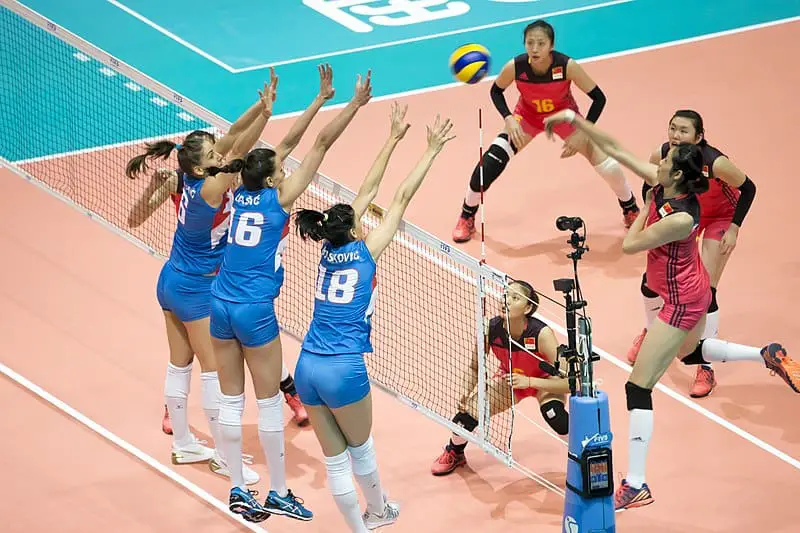
Now this is a very general guide to blocking however as with all complex skills there is much finer and greater detail we can go into.
In this article I am not only going to cover exactly how to block but also what each player’s role is when blocking.
Table of Contents
Full Guide To Blocking
We have all seen those plays when we are watching high level or international tournaments and someone pulls off the monster block and the ball just goes vertically down.
There is nothing quite like it.
Now you may be completely new to Volleyball and have never even attempted blocking, or you might have a little bit of experience but when you block the ball always flies off your block like it’s hit a flat wall.
Regardless of which stage you are at, it’s important to know exactly how and more importantly why we block in the way we do to ensure next time you step on the court you can claim that monster block badge.
Now one of the most important aspects of blocking is positioning, you can be the best blocker in the world but if where you are positioned allows the attacker to swing straight past you it won’t do you much good.
Now with that being said I am going to touch on how and where you should be blocking for each position later on in the article, so to start with, let’s assume you are lining up in the perfect place.
The next step to being a fantastic blocker stability.
Stability When Blocking
This may sound strange and without an explanation I will admit it looks like an odd heading.
So what exactly do I mean by stability?
Well when you are preparing to jump it is important that you are stable and not off balance. Being off balance will not reduce the height you can jump considerably but it can also lead to you drifting too wide or even jumping straight into the net and committing a fault.
So with this in mind the first part of any good block to me is stability.
Once we have found that perfect lineup we want to ensure we are well balanced and ready to jump straight up and down to intercept the ball as it’s hit.
The next most important aspect is timing.
Timing When Blocking
Again you can be the best blocker in the world but if you are always blocking before the hitter is reaching the peak of their jump it won’t do you much good as you will just continuously watch people hitting straight over you.
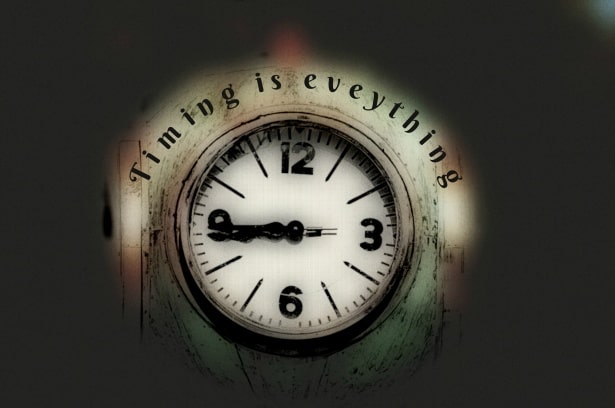
Now timing is something that can’t really be taught as it requires a certain amount of situational awareness, on top of this each opponent will have their own individual tendencies.
For example some players may hit the ball quite late and quickly meaning the ball is hit low, whereas other players may jump higher and take the ball early.
Learning these little tendencies can really help you win more individual battles against your opposite number, so next time when you play maybe use the first 10 points or so to really get a read on the opposition attackers.
As a general rule of thumb though is you are leaving the ground just after the hitter has jumped you should be at the peak of your jump just after they contact the ball.
Now I know this timing can be difficult to judge but just watch, read the hitters approach and react.
Now we have a nice stable platform to jump off and understand when we need to jump it’s time to cover exactly how we go about blocking.
Hand and arm Position
The first thing I want to cover is what we should do with our hands and arms when getting ready to block.
When blocking we only have a split second to intercept that ball between the time it takes them to jump and hit and when we block.
With this in mind it is important that our arms and hands are already up and ready. If we leave our arms down by our sides when we jump, by the time we have pulled our arms up to block the ball could already be sailing past.
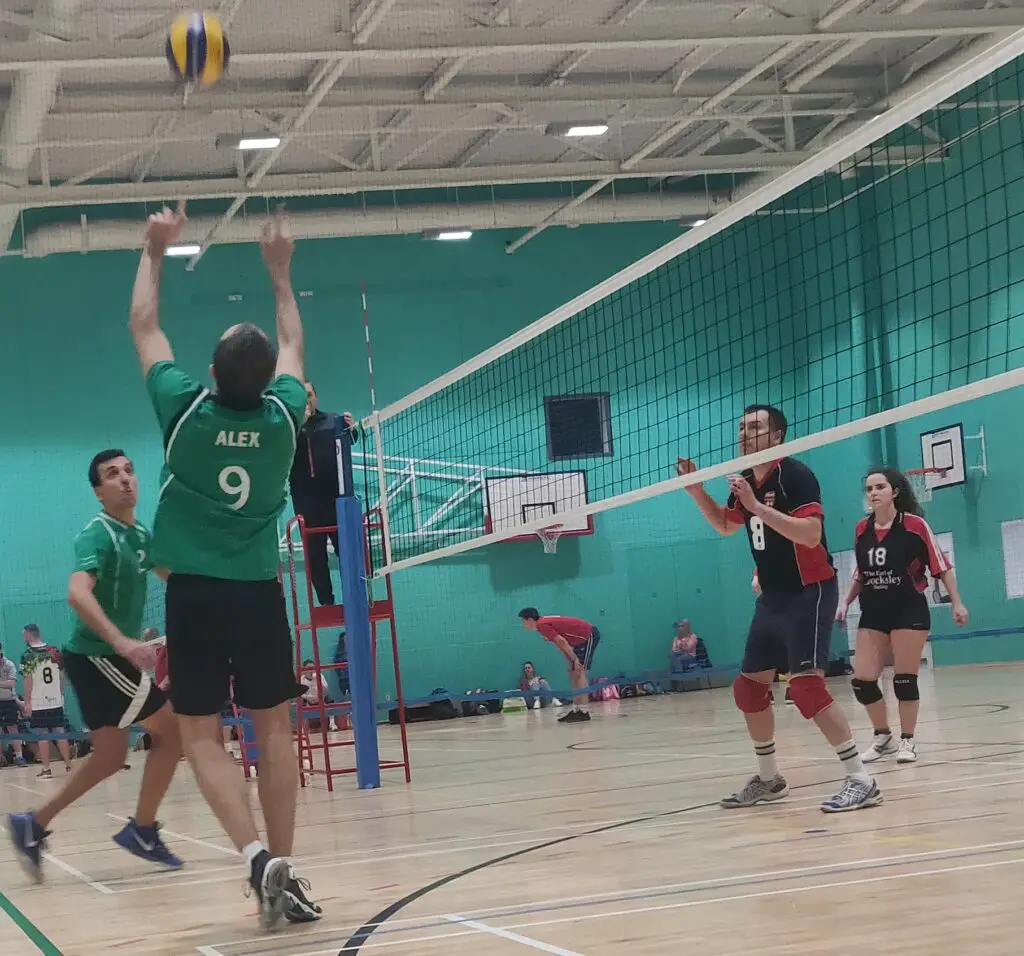
When we are blocking it is normally most efficient to have our hands and arms up in front of us with our hands around head level.
This way they are in a nice comfortable position for us to jump but also they are up and ready to reach and press allowing us to react much quicker.
Jumping To Block
Once we have our hands up and ready we obviously need to execute the jump.
Now unlike the hitter who likely has a running approach we unfortunately don’t have that luxury and must perform a standing vertical jump.
To ensure we get the maximum height possible when blocking we need to squat down and compress the muscles to allow us to explode upwards.
Think of it like a spring being pushed down, the second you release that compressed spring it propels upwards.

This is similar to what we need to do with our bodies.
To ensure when we jump we don’t catapult forwards it is important that when we squat down we keep our chest upright and facing forwards.
By collapsing our bodies we have no control over where we end up jumping.
So with a tight core and upright chest we want to squat down and compress the leg muscles and then when the time is right straighten the legs, explode upwards and then reach upwards with our hands and arms.
Pressing The Block
We now have the perfect lineup, immaculate timing and a great explosive jump.
Now it’s time to form the roof and start getting monster blocks.
To get monster blocks it takes a combination of all of these key components however if you want to master one thing to greatly increase your chances it is the art of pressing blocks.
Now what this means is when we are jumping and our hands and arms cross the top of the net we actually want to reach over the net to cut down the angle and time that the hitter has to attack the ball.
By pressing the block over and forming almost a roof over the hitter you can start getting those vertical down blocks.

As we press over the net if we turn our thumbs towards the sky you will notice that your hands will open outwards. By doing this motion you create a larger surface area that you can block with, it also helps reduce the gap between your arms and locks out your block to ensure the ball is only going one way if it hits you and that is back on the opponent’s side.
The last thing that we need to consider when we are pressing our block is at what direction we want the ball to go back on the opponent’s side.
Now yes vertically down is lovely but not always that realistic so with this in mind we need to make a couple of adjustments when pressing our blocks.
If the player is hitting from the near the right side line we want to ensure that if the player hits into our block that it will ricochet back towards the middle of the court as opposed to off the block and out of bounds.
To ensure this happens we need to create a good angle with our block.
The best of creating this angle without affecting the integrity of the block is to press our outside arm slightly further over than our inside arm.
So in the example of the attacker hitting from the right side line, we would want to press our right arm slightly further over the net than our left arm.
By doing this we create a nice angle back towards the centre of the court without having to change our blocking form or stance.
Landing From The Block
Regardless of whether the ball gets blocked or not we still want to ensure when we finish blocking we pull our arms back over the net to our own side ensuring we avoid the net at all times and land carefully protecting our heels and knees.
Aside from this though we need to ensure when we land we are still watching the game and ready for anything.
There have been many occasions where I have roofed people and thought the point was in the bag only to see a libero like a guardian angel underneath the attacker saving the point.
There have also been times where I have blocked players only for it to bounce off their heads or shoulders and come flying back over.
These are just a couple of scenarios but the beautiful thing with volleyball is it’s unpredictable so regardless of the outcome the second you land be ready for anything.
So there you have it, everything you need to know about how to perform a monster block in volleyball.
Now I said I was going to come back to positioning and what areas of the court each individual player is responsible for blocking at the start of the article and that time has now come.
How To Block As An Outside hitter
An outside player generally has a lot of responsibility placed on them from being a consistent passer, strong hitter and even a versatile blocker.
As an outside hitter in position 4 they will generally be responsible for blocking 2 of the opposition players, these two players would be the Opposite (AKA Rightside Hitter) and the setter.
When the setter is in the front court it is very unlikely that they will be set and they will attack the ball.
With this in mind, how we would lineup for blocking the setter would be very different to how we would want to line up against an opposite hitter.
Blocking the Setter
Often setters will win points by dumping the ball or with little quick sets just over the net. In either case as the outside player in this situation it is important that we watch and react to these shots.
Now this can be a thankless job as clever setters are very difficult to read, alas we must do our bit for the team and try to block them.
When it comes to lining up against a setter it is first important to note if they are left handed or not (or at least capable of hitting with their left) because if the setter feels comfortable hitting with their left it always means there is a chance they will hit the ball on 2 rather than setting.
Once we have established if they are likely to hit the 2nd ball we can then work on our positioning and lineup.
Now based on the fact that the setter likely isn’t going to hit the 2nd ball or play the ball over on the second touch this does mean we can stand nearer the middle of the court to help the middle blocker with the quick middles.
It also means as we are more stacked towards the centre of the court we even have a chance of helping out the opposite with a triple block.
Another reason why we can stack towards the middle a little bit more is because of where the pass on the other side is coming from.
Now what I mean by this is because the setter is nearly always in front of the pass even if they do want to jump and hit the 2nd ball it is almost impossible for them to hit down the line as the angle is just too sharp. This means they are likely to dump, tip or even spike cross court.
With this in mind as an outside blocker when lining up against a setter we can line our left arm up with their hitting arm so the majority of our block is to the right side of them.
This way the setter does not have the option of hitting, dumping or tipping cross without having to go over the block which the back court players can mop up.
Blocking the Opposite/ Right side Hitter
When it comes to blocking the opposite we have two things to consider, the first is how we block them when front court vs how we block them when they are hitting back court.
When the opposite is front court again we first need to ascertain if the hitter is right or left handed as this will affect slightly where we want to position ourselves. It is quite common for opposites to be left handers.
Once we have confirmed which hand they are we can start working out exactly how we want to line up.
Now it is important to note that if your team has a certain tactic they like to implement then you should listen to this first and foremost over anything I write.
For example when I play in the local league that my area holds the level isn’t really high so not many of the opposition can hit a steep line swing, as such we tend to favour a cross court block as any line hits can be scooped up by the defender with relative ease.
With that being said though as a general rule of thumb I think it is important to take away a hitters line shot. The reason I say this is because the line swing is the quickest hit they can do and it gives the defenders little to no time to react.
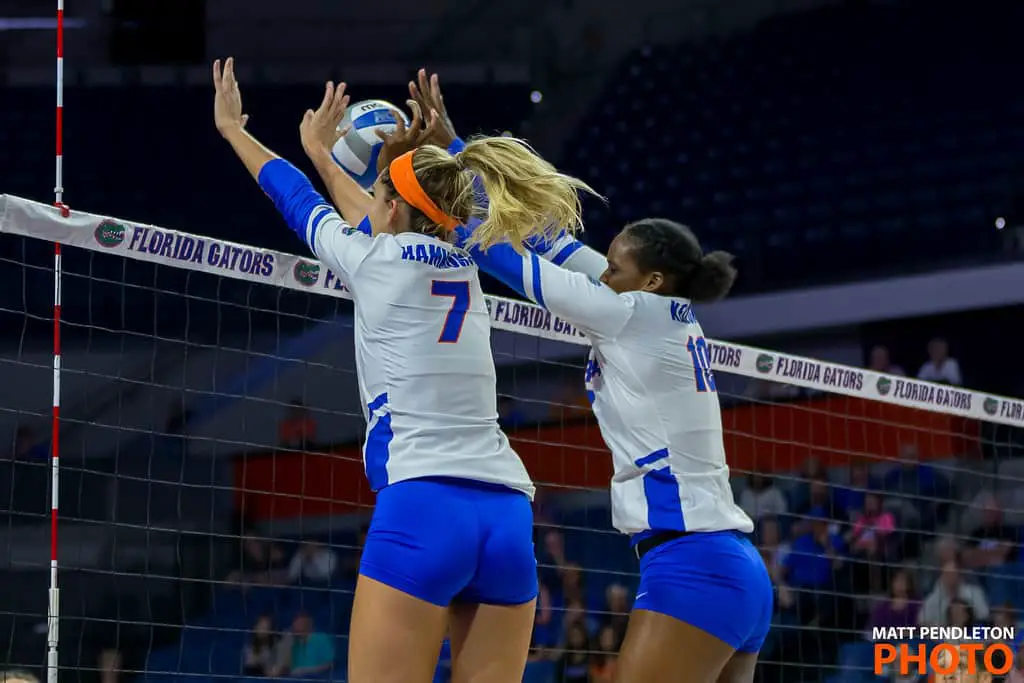
Although the cross court hit may have more power generally speaking it gives the defenders more time to read the hit and react.
If the opposite is right handed to ensure we take away the line angle, we want to stand just inside the antenna and try to line up so that when the hitter is swinging if they continue their arm swing it would cut our body clean in half.
So we want to ensure we line up so that their right arm is perfectly in the centre of our body. By doing this we take away their line angle as well as smother the ball if they are to hit straight at us.
If the hitter was left handed we would want to adopt the same position however we would try and ensure the centre of our block was in line with their left arm.
As mentioned above when I was going through the detailed blocking guide we want to ensure that we not only take the line angle away but if they do try and hit it we are turning the ball back into the centre of the court, so as the outside we want to push our left arm slightly further forward than our right arm to create that nice angle back in court.
Blocking the Opposite Who Is Back Row
This is where it starts to get a bit more complicated.
If you remember when I mentioned above about how we would almost cheat a little bit when the setter is in the front row and stand nearer the middle of the court to assist the middle blocker.
Well this is where the biggest threat to that tactic comes into play.
When the opposite is back court they will hit what is often known as a 10. A 10 hit is where the player spikes the ball from back court when they are playing position 1.
If you as an outside player have pushed towards the middle more and the opposition go for a back court reverse set we need to make sure we get back out towards the antenna and quick.
When attempting to block a 10 hit generally speaking it is best to try and block ball, this means wherever you think that ball is going is where you try and block.
Obviously this is easier said than done so I tend to lean towards starting by getting out to the antenna and then pushing the block back towards cross as required.
The main benefit that you have as an outside trying to block a back court opposite is there is slightly more time to judge the flight of the ball from when it is hit. This is why I suggest starting by blocking the line and taking away that short angle and then reaching the cross court hit as best you can once you have seen the spike.
To do this we want to replicate the line block that we had when the opposite was front court.
So the position and lineups don’t change that much however the most important this how quickly we get to the correct position and more importantly that before we jump to block we have stopped moving laterally.
If our momentum is still going sideways when we jump to block we will continue to drift in the air.
Not only does this make it very difficult to then reach back cross court but it can also really hurt your back court teammates who might lose sight of the ball behind your block.
By drifting out it also can leave gaps between you and the middle blocker who may be trying to help you block.
So summarising the above, as a priority take away the line swing by making sure your block is right in the centre of their hitting arm. This will ensure they can’t swing round your block down the line as well as ensure you smother the ball if they try and hit directly through you.
How to block As A Middle Blocker
If you are a middle blocker first and foremost I want to say I really feel for you and my god you guys are beasts.
Being a middle is by far the most difficult position to play when it comes to blocking. Not only do you have to worry about a really quick middle hit but you are also expected to help the outside and setter/ opposite block.
Now with that being said if you think there is even a chance that the middle will get set… STAY WITH THEM…
It is much better to leave the wings in a 1v1 blocking situation then it is to give the opposition middle a free hit with no block.
Middle Blocker Blocking Middle Player
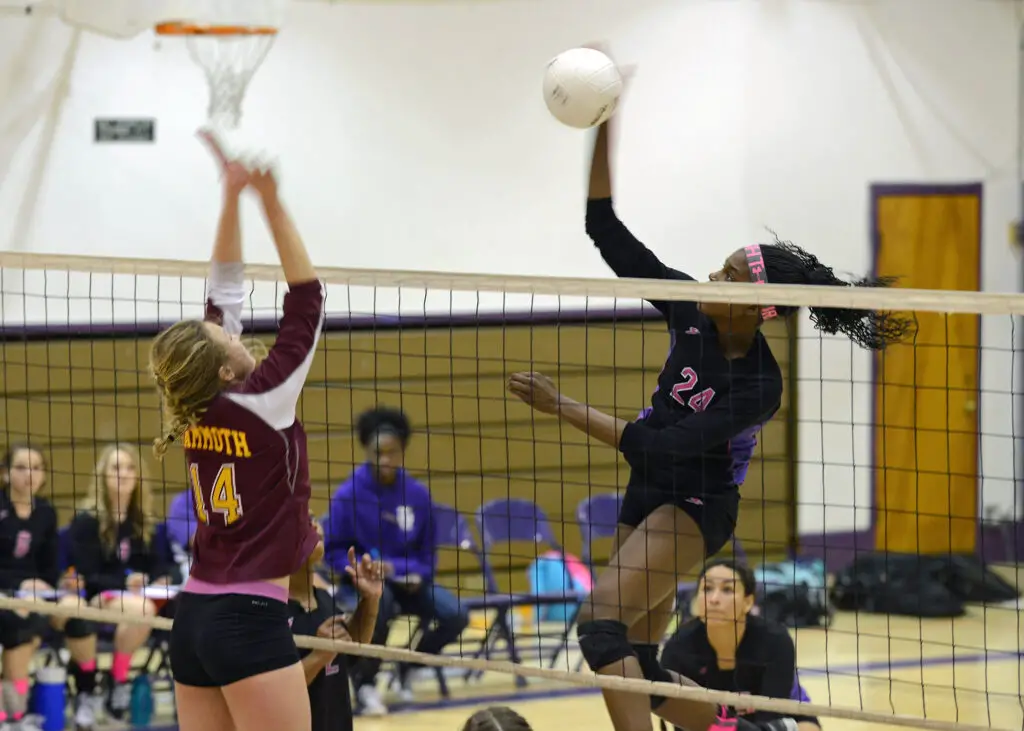
When it comes to blocking a middle player it is normally best to assume the middle will hit in their powerline which for the most part will mean the middle will likely try and spike towards the 5 position.
Obviously the higher up the ranks you go the smarter opponents you will play and they will start turning the ball across their body however this is a much harder hit to execute which generally means its not hit with as much power and allows your defenders more time to react.
Assuming we want to take away the middles power line we obviously want to try and block the ball to ensure it can’t be hit down the middle of the court or towards the 5 position.
In order to block this ball we want to assess the angle that the middle is approaching from and then ensure we again get the centre of our block directly in line with the hitters arm. This way the middle is unable to hit directly down the middle but we also take away some of the cross court angle.
To assist in taking away a little bit more of that powerline angle we would want to press our left arm slightly further over than our right arm to try and turn the ball back into the middle of the court.
Middle Blocking Wing Hitters
When it comes to helping the wing players block it becomes less about forming a lineup yourself and trusting your wing hitter to set the line for you.
When blocking the wings your job is to get out to the wing hitter and seal the gap between their block and yours. As a general rule of thumb you will always try to seal the gap to prevent them hitting the middle of the court and take a large chunk of the cross court when blocking.
If you were blocking the opposite you would want to try and press the left arm over whereas if you were blocking the outside hitter you would want to press the right arm over.
How to Block As a Setter/ Right Side or Opposite
As a player blocking in position 2 whether as a setter/ right side or opposite you may be called upon a lot to block.
Teams will often favour setting to the 4 position be it because they have a strong hitter there or just simply because it is one of the easiest positions to set even with an out of system pass.
Because of this the player blocking them on the other side of the court is often called upon a lot.
Fortunately unlike middle blockers and outside blockers they really only have to worry about a hit from position 4 and assisting the middle as setting a player back court to position 5 is extremely rare.
So you have a nice trade off, you may need to block more however there are very limited options when it comes to who you need to block.
As I mentioned before your team may have a specific tactic in which they want the you to block cross and leave the line open however unless you have specifically been asked to do this, I would also suggest setting up with taking away their line option as again this is the shortest and quickest angle making it hardest to defend.
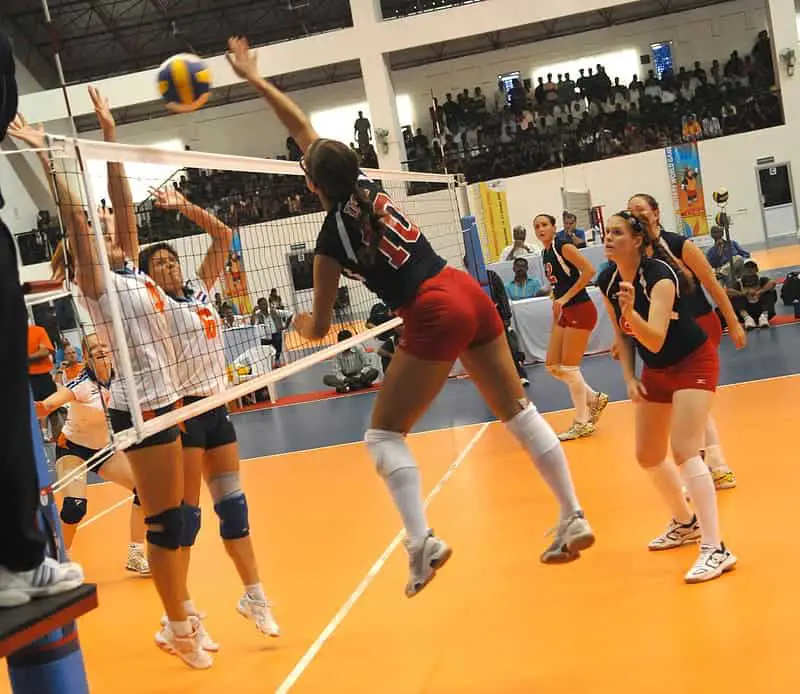
In terms of starting a lineup to block line I feel this position is probably the hardest. The main reason for this is due to the fact the 4 player is often an outlet whether it be an in system or out of system play the set can sometimes be perfect to the antenna, over set or even under set considerably.
With this in mind I am going to default back to my previous lineups of sticking with the hitter and ensuring when you block the centre of your block is directly in line with the hitter.
The only exception to this rule would be if the ball is really overset to the point is has passed the antenna or if it is drastically underset.
When overset you don’t need to be in line with the hitter as they can no longer hit line.
This allows you as a blocker to step in court more and turn your block back to the middle of the court.
Just ensure they can’t hit off the side of your block.
In the opposite situation where the ball is underset I would suggest lining up your inside arm with their hitting arm. This ensures that the block is taking the whole line and they can only swing cross court.
So that’s it.
The full blocking guide from how to execute the perfect block to the ideal lineups and positioning for each front court position.
